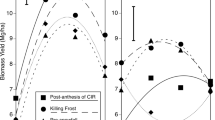Abstract
In dry climates with long, hot summers and freezing winters, such as that of the southern Great Plains of North America, switchgrass (Panicum virgatum L.) has proven potential as a cellulosic bioenergy feedstock. This trial looked at dry matter (DM) and N yield dynamics of switchgrass overseeded with cool-season legumes and rye (Secale cereale L.), compared to switchgrass fertilized with 0, 56 and 112 kg N ha-1 yr-1 at an infertile and a fertile location. Optimal N fertilizer rate on switchgrass was 56 kg N ha-1 at the infertile location. Legume yield was greater in the first season after planting, compared to subsequent years where annual legumes were allowed to reseed and alfalfa (Medicago sativa L.) was allowed to grow. This suggests that the reseeding model for annual legumes will not work in switchgrass swards grown for biomass unless soil seed banks are built up for more than one year, and that overseeding with alfalfa may have to be repeated in subsequent years to build up plant populations. Overseeding rye and legumes generally did not suppress or enhance switchgrass biomass production compared to unfertilized switchgrass. However, cumulative spring and fall biomass yields were generally greater due to winter and spring legume production, which could be beneficial for grazing or soil conservation systems, but not necessarily for once-yearly late autumn harvest biofuel production systems.


Similar content being viewed by others
Abbreviations
- DM:
-
dry matter
- OM:
-
organic matter
References
Sanderson MA, Reed RL, Ocumpaugh WR, Hussey MA, van Esbroeck G, Read JC et al (1999) Switchgrass cultivars and germplasm for biomass feedstock production in Texas. Bioresour Techn 67:209–219
Lemus R, Brummer EC, Burras CL, Moore KJ, Barker MF, Mostad NE (2008) Effects of nitrogen fertilization on biomass yield and quality in large fields of established switchgrass in southern Iowa, USA. Biomass Bioenergy 32:1187–1194
Muir JP, Sanderson MA, Ocumpaugh WR, Jones RM, Reed RL (2001) Biomass production of ‘Alamo’ switchgrass in response to nitrogen, phosphorus, and row spacing. Agron J 93:896–901
Guretzky JA, Biermacher JT, Cook BJ, Kering MK, Mosali J (2011) Switchgrass for forage and bioenergy: harvest and nitrogen rate effects on biomass yields and nutrient composition. Plant Soil 339:69–81
Temperton VM (2007) Positive interactions between nitrogen-fixing legumes and four different neighboring species in a biodiversity experiment. Oecologia 151:190–205
Gettle RM, George JR, Blanchet KM, Buxton DR, Moore KJ (1996) Frost-seeded legumes into established switchgrass: forage yield and botanical composition of the stratified canopy. Agron J 88:555–560
Posler GL, Lenssen AW, Fine GL (1993) Forage yield, quality, compatibility, and persistence of warm-season grass-legume mixtures. Agron J 85:554–560
Bow JR, Muir JP, Weindorf DC, Rosiere RE, Butler TJ (2008) Integration of cool-season annual legumes and dairy manure compost with switchgrass. Crop Sci 48:1621–1628
El Hadj M (2000) compatibility, yield and quality of perennial warm-season grass-legume mixtures. Proc Am Forage Grassl Counc AFGC Georgetown, TX 9:69–73
DeHaan LR, Weisberg S, Tilman D, Fornara D (2010) Agricultural and biofuel implications of a species diversity experiment with native perennial grassland plants. Agric Ecosyst Environ 137:33–38
George JR, Blanchet KM, Gettle RM, Buxton DR, Moore KJ (1995) Yield and botanical composition of legume-interseeded vs. nitrogen-fertilized switchgrass. Agron J 87:1147–1153
Mikkelson GM (2011) Diversity and the good. In: deLaplant K, Brown B, Peacock KA (eds) Philosophy of Ecology. Handbook of the Philosophy of Science Vol. 11. New Holland, Oxford, pp 399–415
Tilman D, Hill J, Lehman C (2006) Carbon-negative biofuels from low-input high-diversity grassland biomass. Science 314:1598–1600
Braden IS (2002) Composition and special distribution of legume mixtures within warm-season grass pastures. pp 276-280. Proc Am Forage Grassl Counc AFGC Georgetown, TX 11:276–280
Springer TL, Aiken GE, McNew RW (2001) Combining ability of binary mixtures of native, warm-season grasses and legumes. Crop Sci 41:818–823
Muir JP, Pitman WD (2004) Establishment of Desmanthus spp. in existing grass stands. Native Plant J 5:5–13
Wang D, Lebauer DS, Dietze MC (2010) A quantitative review comparing the yield of switchgrass in monocultures and mixtures in relation to climate and management factors. Bioenergy 2:16–25
Muir JP, Bow JR (2009) Herbage, phosphorus and nitrogen yields of winter-season forages on high-phosphorus soil. Agron J 101:764–768
Blanchet KM, George JR, Gettle RM, Buxton DR, Moore KJ (1995) Establishment and persistence of legumes interseeded into switchgrass. Agron J 87:935–941
SAS Institute (2002) SAS Proprietary Software Version 9.1. SAS Inst, Cary
Cherr CM, Sholberg JMS, McSorley (2006) Green manure approaches to crop production: a synthesis. Agron J 98:302–319
Njunie MN, Wagger MG, Luna-Orea P (2004) Residue decomposition and nutrient release dynamics from two tropical forage legumes in a Kenyan environment. Agron J 96:1073–1081
Author information
Authors and Affiliations
Corresponding author
Rights and permissions
About this article
Cite this article
Butler, T.J., Muir, J.P., Huo, C. et al. Switchgrass Biomass and Nitrogen Yield with Over-Seeded Cool-season Forages in the Southern Great Plains. Bioenerg. Res. 6, 44–52 (2013). https://doi.org/10.1007/s12155-012-9225-z
Published:
Issue Date:
DOI: https://doi.org/10.1007/s12155-012-9225-z




